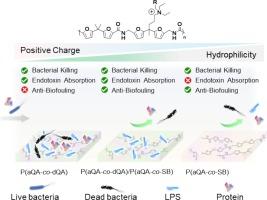Balancing hydrophobicity and surface potential in bio-based bisfuran-containing polyamide coatings for enhanced long-term antibacterial efficacy and endotoxin adsorption
IF 5.8
2区 化学
Q1 POLYMER SCIENCE
引用次数: 0
Abstract
To develop antimicrobial protective materials based on renewable polymers, we synthesized a series of bio-based bisfuran-based polyamide (bFPA) polymers with various functional groups, including allyl quaternary ammonium cations, decyl quaternary ammonium cations, and sulfonate betaine. These bFPA-based coating materials, featuring excellent thermal stability (>230 °C) and biocompatibility, were facilely fabricated on polyurethane (PU) substrates by blending and crosslinking with unsaturated aliphatic PU resin. By altering the combination of different functional groups in bFPA polymers, we controlled the hydrophilicity/hydrophobicity and surface charge properties of the bio-based coating. Compared to pure PU coatings, the bFPA-based coatings with moderate hydrophilicity/hydrophobicity and surface potential significantly reduced the adhesion of model protein and bacteria by approximately 70 % and >99 %, respectively, demonstrating outstanding anti-protein and anti-bacterial adhesion properties. Even after seven cycles of use, the coatings maintained the ability to kill ∼80 % and >99 % of Gram-negative Escherichia coli and Gram-positive Staphylococcus aureus bacteria, respectively, indicating long-lasting antibacterial activity. Additionally, the optimized bFPA-based coatings effectively adsorbed ∼80 % of endotoxins from damaged Gram-negative bacteria through electrostatic interactions, thereby reducing the risk of inflammation and sepsis. The development of bio-based polyamide coatings with long-term antibacterial and endotoxin adsorption properties significantly advances their safe and reliable application of in the field of biomedical devices.

平衡生物基含双呋喃聚酰胺涂层的疏水性和表面电位,提高长期抗菌效果和内毒素吸附性
为了开发基于可再生聚合物的抗菌保护材料,我们合成了一系列具有不同官能团(包括烯丙基季铵盐、癸基季铵盐和磺酸甜菜碱)的生物基双氟呋喃基聚酰胺(bFPA)聚合物。通过与不饱和脂肪族聚氨酯树脂混合和交联,可在聚氨酯(PU)基材上方便地制造出这些基于 bFPA 的涂层材料,它们具有优异的热稳定性(230 °C)和生物相容性。通过改变双酚A聚合物中不同官能团的组合,我们控制了生物基涂层的亲水性/疏水性和表面电荷特性。与纯聚氨酯涂层相比,亲水性/疏水性和表面电位适中的 bFPA 基涂层能显著降低模型蛋白质和细菌的附着力,降幅分别约为 70% 和 99%,显示出出色的抗蛋白质和抗细菌附着性能。即使在使用七个周期后,涂层仍能分别杀死 80% 和 99% 的革兰氏阴性大肠杆菌和革兰氏阳性金黄色葡萄球菌,这表明涂层具有持久的抗菌活性。此外,优化的生物基聚酰胺涂层通过静电相互作用,有效吸附了 80% 的受损革兰氏阴性细菌的内毒素,从而降低了炎症和败血症的风险。具有长期抗菌和内毒素吸附特性的生物基聚酰胺涂层的开发,大大推进了其在生物医学设备领域安全可靠的应用。
本文章由计算机程序翻译,如有差异,请以英文原文为准。
求助全文
约1分钟内获得全文
求助全文
来源期刊

European Polymer Journal
化学-高分子科学
CiteScore
9.90
自引率
10.00%
发文量
691
审稿时长
23 days
期刊介绍:
European Polymer Journal is dedicated to publishing work on fundamental and applied polymer chemistry and macromolecular materials. The journal covers all aspects of polymer synthesis, including polymerization mechanisms and chemical functional transformations, with a focus on novel polymers and the relationships between molecular structure and polymer properties. In addition, we welcome submissions on bio-based or renewable polymers, stimuli-responsive systems and polymer bio-hybrids. European Polymer Journal also publishes research on the biomedical application of polymers, including drug delivery and regenerative medicine. The main scope is covered but not limited to the following core research areas:
Polymer synthesis and functionalization
• Novel synthetic routes for polymerization, functional modification, controlled/living polymerization and precision polymers.
Stimuli-responsive polymers
• Including shape memory and self-healing polymers.
Supramolecular polymers and self-assembly
• Molecular recognition and higher order polymer structures.
Renewable and sustainable polymers
• Bio-based, biodegradable and anti-microbial polymers and polymeric bio-nanocomposites.
Polymers at interfaces and surfaces
• Chemistry and engineering of surfaces with biological relevance, including patterning, antifouling polymers and polymers for membrane applications.
Biomedical applications and nanomedicine
• Polymers for regenerative medicine, drug delivery molecular release and gene therapy
The scope of European Polymer Journal no longer includes Polymer Physics.
 求助内容:
求助内容: 应助结果提醒方式:
应助结果提醒方式:


